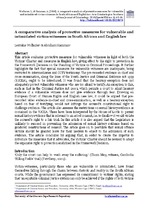| dc.contributor.author | Wolhuter, Lorraine | |
| dc.contributor.author | Hamman, Abraham | |
| dc.date.accessioned | 2017-08-25T11:47:46Z | |
| dc.date.available | 2017-08-25T11:47:46Z | |
| dc.date.issued | 2010 | |
| dc.identifier.citation | Wolhuter, L., & Hamman, A. (2010). A comparative analysis of protective measures for vulnerable and intimidated victim-witnesses in South African and English law. Acta Criminologica: Southern African Journal of Criminology, 2010(Special Edition 1), 42-64. | en_US |
| dc.identifier.issn | 1012-8093 | |
| dc.identifier.uri | http://hdl.handle.net/10566/3153 | |
| dc.identifier.uri | http://hdl.handle.net/10520/EJC28573 | |
| dc.description.abstract | This article evaluates protective measures for vulnerable witnesses in light of both the Victims' Charter and measures in English law, giving effect to the right to protection in the Framework Decision on the Standing of Victims in Criminal Proceedings. It further highlights the fact that special measures for vulnerable witnesses are inadequate, being restricted to intermediaries and CCTV testimony. The pre-recorded evidence-in-chief and cross-examination, along the lines of the Youth Justice and Criminal Evidence Act 1999 (YJCEA), ought to be introduced. It was found that the hearsay exception does not adequately protect vulnerable witnesses who are too afraid to testify. An exception to this, such as that in the Criminal Justice Act 2003, which permits a court to admit hearsay evidence if a vulnerable witness does not give evidence through fear. Drawing on European Court of Human Rights and English case law, it could be argued that pre-recorded video evidence-in-chief and cross-examination, as well as a hearsay exception based on fear of testifying, would not infringe the accused's constitutional right to challenge evidence. The article also assesses the restrictions on sexual history evidence as contained in the YJCEA. These have been interpreted by the House of Lords to permit sexual history evidence that is relevant to an act of consent, i.e. to disallow it would violate the accused's right to a fair trial. In this article it is also argued that the Legislature is unlikely to succeed in preventing the admission of sexual history evidence based on gendered constructions of consent. The article goes on to postulate that sexual offence victims should be granted leave for their lawyers to object to the admission of such evidence. The article concludes by arguing that, in order to create the impetus to introduce the measures that it advocates, the Victims' Charter should be revised to adopt the expansive right to protection enshrined in the Framework Decision. | en_US |
| dc.language.iso | en | en_US |
| dc.publisher | Criminological and Victimological Society of Southern Africa (CRIMSA) | en_US |
| dc.rights | Publisher has granted permission to upload the published version of this article. | |
| dc.subject | Protective measures | en_US |
| dc.subject | Vulnerable witnesses | en_US |
| dc.subject | Victims' charter | en_US |
| dc.subject | English law | en_US |
| dc.title | A comparative analysis of protective measures for vulnerable and intimidated victim-witnesses in South African and English law. | en_US |
| dc.type | Article | en_US |
| dc.privacy.showsubmitter | FALSE | |
| dc.status.ispeerreviewed | TRUE | |
| dc.description.accreditation | DHET | en_US |

